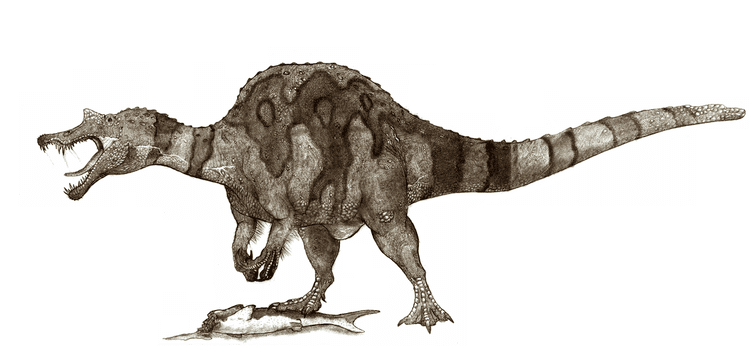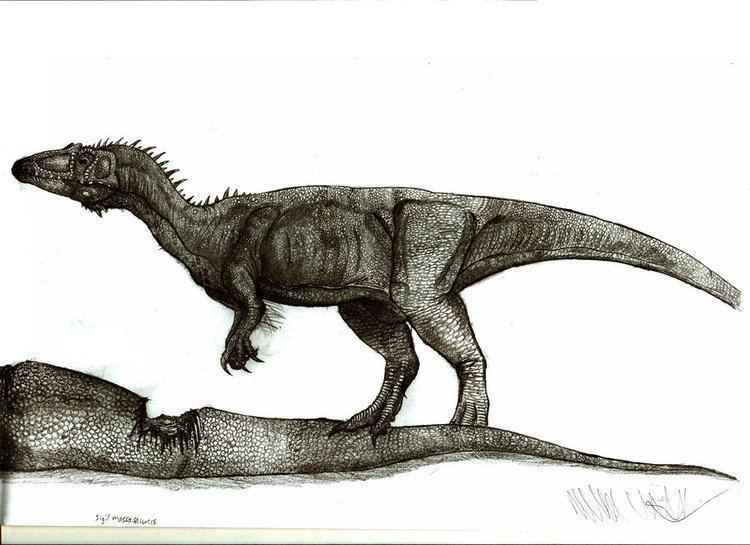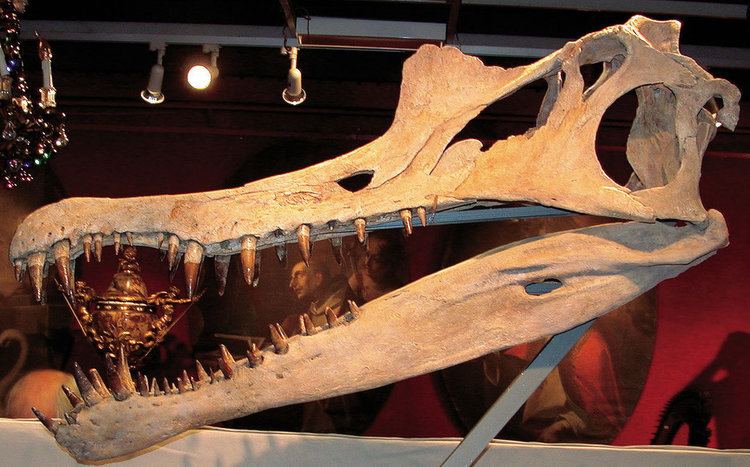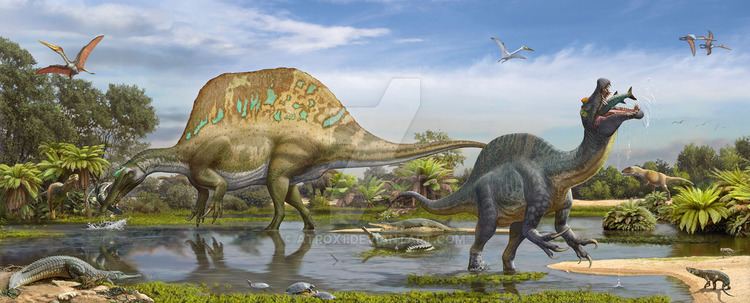Kingdom Animalia Suborder Theropoda Subfamily Spinosaurinae Higher classification Spinosauridae Order Saurischia | Superorder Dinosauria Family Spinosauridae Phylum Chordata Rank Genus | |
 | ||
Similar Dinosaur, Theropods, Spinosauridae, Bahariasaurus, Cristatusaurus | ||
Sigilmassasaurus ("SEE-jill-MAH-sah-SORE-us"; "Sijilmassa lizard") is an extinct genus of tetanuran theropod dinosaur that lived approximately 100 to 94 million years ago during the middle of the Cretaceous Period in what is now northern Africa. Sigilmassasaurus was a moderately-built, ground-dwelling, bipedal carnivore, like most other theropods.
Contents
Discovery

Fossils of this dinosaur were recovered at the Kem Kem Formation in the Tafilalt Oasis region of Morocco, near the site of the ancient city of Sijilmassa, for which it was named. Canadian paleontologist Dale Russell named Sigilmassasaurus in 1996, from the ancient city and the Greek word sauros ("lizard"). A single species was named, S. brevicollis, which is derived from the Latin brevis ("short") and collum ("neck"), because the neck vertebrae are very short from front to back.
Sigilmassasaurus comes from red sandstone sediments in southern Morocco, which are known by various names, including the Grès rouges infracénomaniens, Continental Red Beds, and lower Kem Kem Beds. These rocks date back to the Cenomanian, the earliest stage of the Late Cretaceous Period, approximately 100 to 94 million years ago.
Disputed validity

The holotype, or original specimen, of S. brevicollis, CMN 41857, is a single posterior neck vertebra, although Russell referred about fifteen other vertebrae found in the same formation to the species. Other material had been found in Egypt, and was known as "Spinosaurus B" (Stromer, 1934). Russell considered this Egyptian specimen, IPHG 1922 X45, to belong to Sigilmassasaurus or a closely related animal, naming it as a Sigilmassasaurus sp. A second Sigilmassasaurus sp. was by him based on specimen CMN 41629, an anterior dorsal vertebra. "Spinosaurus B" would be intermediate in build between this latter Sigilmassasaurus sp. and S. brevicollis. Russell created the family Sigilmassasauridae for these animals (Russell, 1996). The neck vertebrae of these dinosaurs are wider from side to side, about 50%, than they are long from front to back. Whether the neck as a whole was particularly short, is unknown: the holotype vertebra is a cervicodorsal, from the transition between the neck and the back, which would not be long anyway. The exact position of Sigilmassasaurus within the theropod family tree is unknown, but it belongs somewhere inside the theropod subgroup known as Tetanurae.

The validity of Sigilmassaurus, however, did not go unchallenged shortly after it was named. In 1996, Paul Sereno and colleagues described a Carcharodontosaurus skull (SGM-Din-1) from Morocco, as well as a neck vertebra (SGM-Din-3) which resembled that of "Spinosaurus B," which they therefore synonymized with Carcharodontosaurus (Sereno et al., 1996). A later study went further, calling Sigilmassasaurus itself a junior synonym of Carcharodontosaurus (Sereno et al., 1998).

More recently, however, it was revealed that SGM-Din-3, which was used to synonymize Carcharodontosaurus and "Spinosaurus B" was not actually associated with SGM-Din-1, the Carcharodontosaurus skull described in 1996, and shows clear differences with the holotype of Carcharodontosaurus. Other features of "Spinosaurus B" also clearly differ from Carcharodontosaurus, lending support to the notion that it (and therefore Sigilmassasaurus) is a separate taxon. The same study claimed that the tail vertebrae by Russell assigned to the species were in fact those of iguanodonts (Novas et al., 2005). A study in 2013 confirmed that Sigilmassasaurus was valid and an indeterminate member of the Tetanurae.
In Ibrahim et al. (2014), the specimens of Sigilmassasaurus were referred to Spinosaurus aegyptiacus, together with "Spinosaurus B" as the neotype, and Spinosaurus maroccanus was considered as a nomen dubium following the conclusions of the other papers. In a 2015 re-description of Sigilmassasaurus, it was considered a valid genus, belonging to Spinosauridae. This re-description also proposed Spinosaurus maroccanus as a junior synonym of Sigilmassaurus, and rejected the proposal of a Spinosaurus aegyptiacus neotype.
Paleoecology
Several large theropods (more than one tonne) are known from the Cenomanian of northern Africa, raising questions about how such animals would have coexisted. Species of Spinosaurus, the largest known theropod, has been found in both Morocco and Egypt, as has the huge Carcharodontosaurus. Two smaller theropods, Deltadromeus and Bahariasaurus, have also been found in Morocco and Egypt, respectively, and may be closely related or possibly the same genus. Sigilmassasaurus, from Morocco, and "Spinosaurus B", from Egypt, represent a fourth type of large predator. This situation resembles that in the Late Jurassic Morrison Formation of North America, which boasts up to five theropod genera over one tonne in weight, as well as several smaller genera (Henderson, 1998; Holtz et al., 2004). Differences in head shape and body size among the large North African theropods may have been enough to allow niche partitioning as seen among the many different predator species found today in the African savanna (Farlow & Pianka, 2002).
